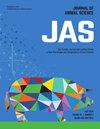Impact of Initial Postweaning Feed Intake on Weanling Piglet Metabolism, Gut Health, and Immunity
IF 2.7
2区 农林科学
Q1 AGRICULTURE, DAIRY & ANIMAL SCIENCE
引用次数: 0
Abstract
Low feed intake in weanling pigs can be hypothesized as both cause and consequence to intestinal disturbances and metabolic stress. We explored the associations between individual daily feed intake (FI) patterns, metabolic status and intestinal physiology. Female pigs (n = 24) were selected based on high or low cumulative FI between d1 and d3 relative to weaning (d0) from 12 pens equipped with electronic feeding stations at 1-week after weaning for dissection and sampling. Four classes of pigs were created with pigs which started with a high or low FI (d1 to d3) and continued with a high or low FI (d4 to d6) (HH, HL, LH and LL, respectively; n = 6) for data analysis. In plasma, HL pigs showed higher plasma glutamate dehydrogenase than LL pigs (P < 0.05). A low FI d1 to d3 increased plasma creatinine and lactate dehydrogenase, and reduced insulin-like growth factor (IGF-I), gastrointestinal organ weights, and jejunal villus surface area at one week after weaning (P < 0.05). However, low FI d4 to d6 increased plasma haptoglobin, PigMAP, bile acids and bilirubin levels and reduced jejunal villus length (P < 0.05). In jejunum tissue, HH pigs had the highest jejunal upregulated IGF-I receptor and a reduced local inflammatory gene expression when compared to HL pigs (MyD88), and similarly, when compared to all classes (FAXDC2). For the main effects, pigs classified as high FI d1 to d3 had upregulated immune system including IL6, TGFB1, TLR2, and TLR4 genes compared to low FI d1 to d3 pigs (P < 0.05). In a multivariate model, variance in ADG (R2 = 0.82) was mostly explained by positive correlations with FI d1 to d3, jejunal morphometrics, and plasma IGF-I, while negatively explained by histamine in digesta, and creatinine, PigMAP, triglycerides, and haptoglobin in plasma. In conclusion, pigs transitioning from high to a low feed intake showed distinct metabolic alterations and a subtle local inflammation masked by the vigorous local immune response in pigs with initial (d1 to d3) high FI. Pigs with an initial low FI had a fasting-like metabolic state, indicated by hepatic alterations pointing at shifting protein metabolism into energy production. Altogether, feed intake during the initial days postweaning significantly impacts pig growth, immunity, and metabolism, with sustained low intake (i.e. up to 6 days) triggering a systemic inflammatory response.断奶后初始采食量对断奶仔猪代谢、肠道健康和免疫的影响
断奶仔猪的低采食量可能是肠道紊乱和代谢应激的原因和结果。我们探讨了个体日采食量(FI)模式、代谢状态和肠道生理之间的关系。在断奶后1周,根据d1和d3相对于断奶(d0)的累积FI值高低,从12个配备电子饲养站的猪圈中选择24头母猪进行解剖和取样。从高或低FI (d1 ~ d3)开始,到高或低FI (d4 ~ d6),分别饲喂HH、HL、LH和LL 4类猪;N = 6)进行数据分析。血浆中,HL猪谷氨酸脱氢酶高于LL猪(P <;0.05)。低FI d1至d3增加了断奶后一周血浆肌酐和乳酸脱氢酶,降低了胰岛素样生长因子(IGF-I)、胃肠道器官重量和空肠绒毛表面积(P <;0.05)。然而,低FI d4至d6增加了血浆触珠蛋白、PigMAP、胆汁酸和胆红素水平,减少了空肠绒毛长度(P <;0.05)。在空肠组织中,与HL猪相比,HH猪空肠IGF-I受体上调最高(MyD88),局部炎症基因表达减少(FAXDC2),与所有类别猪相比也是如此。对于主要影响,与低FI d1至d3猪相比,高FI d1至d3猪的免疫系统包括IL6、TGFB1、TLR2和TLR4基因上调(P <;0.05)。在多变量模型中,ADG的方差(R2 = 0.82)主要与FI d1至d3、空肠形态计量学和血浆IGF-I呈正相关,而与食糜组胺、血浆肌酐、PigMAP、甘油三酯和接触球蛋白负相关。综上所述,从高采食量过渡到低采食量的猪表现出明显的代谢改变和轻微的局部炎症,被初始(d1至d3)高FI猪强烈的局部免疫反应所掩盖。初始低FI的猪具有类似禁食的代谢状态,肝脏改变表明蛋白质代谢转变为能量生产。总之,断奶后最初几天的采食量显著影响猪的生长、免疫和代谢,持续低采食量(即长达6天)会引发全身炎症反应。
本文章由计算机程序翻译,如有差异,请以英文原文为准。
求助全文
约1分钟内获得全文
求助全文
来源期刊

Journal of animal science
农林科学-奶制品与动物科学
CiteScore
4.80
自引率
12.10%
发文量
1589
审稿时长
3 months
期刊介绍:
The Journal of Animal Science (JAS) is the premier journal for animal science and serves as the leading source of new knowledge and perspective in this area. JAS publishes more than 500 fully reviewed research articles, invited reviews, technical notes, and letters to the editor each year.
Articles published in JAS encompass a broad range of research topics in animal production and fundamental aspects of genetics, nutrition, physiology, and preparation and utilization of animal products. Articles typically report research with beef cattle, companion animals, goats, horses, pigs, and sheep; however, studies involving other farm animals, aquatic and wildlife species, and laboratory animal species that address fundamental questions related to livestock and companion animal biology will be considered for publication.
 求助内容:
求助内容: 应助结果提醒方式:
应助结果提醒方式:


